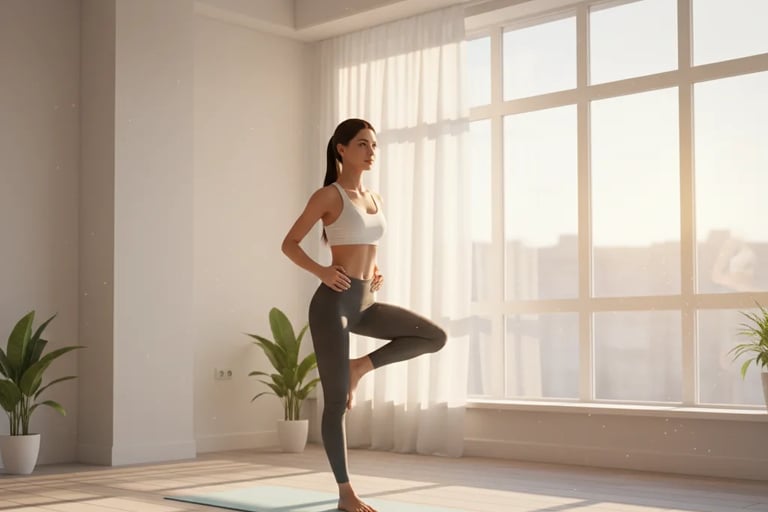11 Science-Backed Benefits of Morning Sunlight Exposure for Body & Mind
Discover 11 powerful benefits of morning sunlight for your body and mind. Boost mood, sleep, energy, and heart health with simple, science-based daily sunlight habits.
HEALTH & AWARNESS
Tapas Kumar Basu
10/18/20257 min read


There is a simple, free health habit waiting for you every morning: sunlight. Not the harsh midday sun that strongly suggests reaching for sunscreen, but the gentle early-morning light that helps set your body’s internal clock, lifts mood, and supports several vital systems. From boosting sleep quality to improving heart health, morning sunlight is one of those small, high-return habits that nature gives freely.
In this article, we’ll explore 11 science-backed benefits of morning sunlight exposure, explain the science in plain language, and provide practical tips so you can use it in daily life. Whether you are a student, professional, or retiree, these small morning rituals can make a big difference.
Why Morning Light Matters
Our brains and bodies rely on a daily light–dark cycle to regulate sleep, hormones, metabolism, and mood. Specialized retinal cells, called intrinsically photosensitive retinal ganglion cells (ipRGCs), sense natural light and send signals to the brain’s master clock — the suprachiasmatic nucleus. Morning sunlight gives that clock a firm nudge: “Hey, it’s daytime, start the engine.”
This simple nudge sets off a cascade of benefits, helping to align hormone rhythms, improve sleep quality, enhance alertness, and even support cardiovascular and immune function. Essentially, morning light helps your body know when to start and stop daily physiological processes, giving you a natural advantage for energy, focus, and overall well-being.
1. Resets Your Circadian Rhythm — Sleep and Wake Better
Morning light is the strongest environmental cue for synchronizing your circadian rhythm. By stepping outside within the first hour after waking, you help your internal clock reset daily. Research shows that people who consistently get morning sunlight tend to fall asleep earlier, sleep more soundly, and wake feeling refreshed.
Practical example: Try a 15–20 minute walk outside within an hour of sunrise. Even standing by a window with unobstructed sunlight helps reinforce your sleep-wake cycle. Over time, this can reduce dependence on caffeine and stabilize energy levels throughout the day.
Fun fact: Just 20 minutes of early sunlight provides enough blue light to stimulate alertness comparable to a 100W indoor bulb — without the electricity bill.
2. Boosts Mood and Reduces Depressive Symptoms
Early light exposure increases signals that regulate mood-related neurotransmitters such as serotonin. Clinical studies show that morning light therapy is effective for seasonal affective disorder (SAD) and can complement treatment for non-seasonal depression. Even short outdoor sessions in the morning can improve mood, motivation, and emotional resilience.
Practical example: Pair a brief morning walk with deep breathing, stretching, or a mindfulness exercise. Over weeks, consistent exposure creates a positive emotional cycle, making daily tasks feel easier and more enjoyable.
Seasonal tip: In winter, step outside even on cloudy mornings. The diffuse light still benefits your circadian rhythm and mood.
3. Improves Alertness, Cognition, and Productivity
Morning sunlight is rich in blue wavelengths that promote alertness and cognitive performance. People exposed to morning light report better focus, faster reaction times, and less daytime sleepiness.
Practical example: Schedule important tasks for mid-morning after 15–20 minutes of outdoor exposure. This natural boost can enhance productivity and mental clarity without caffeine.
Extra tip: Combine sunlight exposure with light stretching or a brisk walk — physical movement further sharpens cognitive performance.
4. Regulates Melatonin for Deeper Night-time Sleep
Melatonin, the “sleep hormone,” is suppressed by morning light and naturally rises at night. Exposure to sunlight in the early hours strengthens this rhythm, promoting deeper, more restorative sleep.
Practical example: Avoid indoor fluorescent lights during the first 30–60 minutes after waking. Step outside or open your curtains fully. Over time, your body produces melatonin at the right time, reducing night awakenings and improving sleep efficiency.
Mini anecdote: Many people report that consistent morning sunlight makes them feel “naturally tired” at night, reducing reliance on sleep aids.
5. Supports Vitamin D Production
UVB rays from sunlight trigger vitamin D production in the skin, essential for bone health, immune function, and mood regulation. While midday sun is most efficient, morning exposure contributes to overall vitamin D balance.
Practical example: Combine morning exposure with a diet rich in vitamin D, such as fatty fish, fortified dairy, or eggs. Adjust exposure based on skin tone — darker skin may need 20–30 minutes, while lighter skin may require only 10–15 minutes.
Seasonal tip: In winter or high-latitude regions, consider supplementing vitamin D while keeping morning sunlight as a circadian rhythm anchor.
6. Can Lower Blood Pressure via Nitric Oxide Release
UVA rays from sunlight trigger the release of nitric oxide stored in the skin, relaxing blood vessels and reducing blood pressure. This cardiovascular effect is independent of vitamin D and provides a natural heart-health benefit.
Practical example: A 10–20 minute morning walk in natural light can improve vascular function. Pair it with hydration and light stretching for enhanced effects.
Extra tip: Morning sunlight combined with mindful breathing exercises may further optimize blood pressure regulation.
7. Supports Immune and Metabolic Health
Light exposure regulates circadian rhythms, coordinating hormone secretion, metabolism, and immune function. Disrupted light cycles are linked to metabolic and immune irregularities, while proper morning exposure ensures normal timing for digestion, hormone release, and immune activity.
Practical example: Incorporate a short morning sunlight routine with gentle yoga or stretches to maximize both circadian and metabolic benefits.
Extra insight: Research suggests even short, consistent exposure enhances natural killer cell activity, supporting immune defenses.
8. Eases Symptoms of Seasonal Affective Disorder (SAD)
SAD arises from insufficient light in winter months. Morning sunlight exposure — or clinical light therapy if needed — alleviates fatigue, low mood, and reduced motivation.
Practical example: Step outside for 15–30 minutes within an hour of sunrise during winter months. If outdoor access is limited, a bright light therapy lamp can provide a similar benefit.
Pro tip: Combine light exposure with physical activity or a morning walk to amplify mood improvements.
9. Enhances Mood Through Social and Behavioural Cascades
Morning sunlight often coincides with positive behaviours: walking, exercising, journaling, or brief social interactions. These routines amplify sunlight’s physiological effects, promoting better mood, energy, and engagement.
Practical example: Invite a friend for a sunrise walk or enjoy your morning coffee outside. The combination of social interaction, movement, and sunlight creates a compounding effect on well-being.
Mini anecdote: People who routinely combine morning sunlight with journaling or exercise report more sustained energy and motivation throughout the day.


10. Improves Sleep in Older Adults and Vulnerable Populations
Older adults often experience weaker circadian signals, leading to fragmented sleep and daytime napping. Morning light stabilizes cortisol and melatonin rhythms, improving overall sleep quality. Clinical studies confirm reduced night awakenings and better morning alertness.
Practical example: Encourage seniors to spend 10–20 minutes outdoors after breakfast. Even a few minutes of sunlight exposure can significantly enhance energy and sleep patterns.
Extra tip: Morning sunlight is also helpful for those recovering from illness or with mild sleep disorders, as it gently realigns circadian rhythms.
11. May Reduce All-Cause Mortality Risk When Balanced Sensibly
Observational studies suggest that very low sun exposure is linked to higher all-cause mortality. Balanced morning sunlight supports vitamin D, cardiovascular health, and circadian alignment. Moderation is key — too much midday sun increases UV risk.
Practical example: Start with 10 minutes in the morning, gradually increasing to 30 minutes. Always use sun protection if exposure extends beyond the morning window.
Fun fact: Studies indicate that moderate, regular sun exposure improves overall longevity markers without increasing skin cancer risk when done safely.
Practical, Mobile-Friendly Tips (10–30 Minutes)
Timing matters: Step outside within 30–60 minutes after sunrise. Adjust duration based on skin tone, season, and cloud cover.
Face the sunlight: Briefly remove sunglasses so retinal cells can detect light. Never look directly at the sun.
Pair it with micro-habits: Walk, stretch, journal, or sip your coffee outside. Small routines improve consistency.
Vitamin D considerations: Midday sun or supplementation can complement morning exposure if targeting vitamin D specifically.
Sun protection: Apply sunscreen if remaining outdoors longer than the recommended morning window.
Who Should Be Cautious?
People with photosensitive conditions, medications that increase sun sensitivity, high skin-cancer risk, or bipolar disorder should consult a healthcare professional before increasing sun exposure. Light therapy can, in rare cases, trigger mania in susceptible individuals, so caution and guidance are advised.
Bottom Line
Morning sunlight is one of the most accessible, high-return wellness habits: free, easy, and anchored in physiology. Just 10–30 minutes within the first hour of sunrise can:
Boost mood and motivation
Stabilize circadian rhythm and sleep
Support cardiovascular and metabolic health
Enhance immune function
Promote longevity when combined with safe sun practices
Start with a small daily ritual tomorrow morning. Step outside, face the light, breathe deeply, and notice how your energy, focus, and emotional well-being shift over time. Consistency, not intensity, is the real key to reaping these benefits.
Frequently Asked Questions (FAQs):
1. How much morning sunlight do I need daily?
Most people benefit from 10–30 minutes within the first hour after sunrise. Duration varies with skin tone, season, and cloud cover — lighter skin needs less time, darker skin slightly more. If outdoor access is limited, bright window light can still help.
2. Can morning sunlight improve my sleep?
Yes! Early sunlight resets your circadian rhythm, telling your body when to be awake and when to produce melatonin for deeper, restorative sleep. Regular exposure often improves both falling asleep and waking refreshed.
3. Is morning sunlight safe for all skin types?
Generally, yes. However, people with photosensitive conditions, certain medications, or high skin-cancer risk should consult a healthcare professional. If staying outdoors longer than the recommended time, use sunscreen.
4. Can morning sunlight replace vitamin D supplements?
Morning sunlight helps vitamin D production, but it’s usually less efficient than midday sun. Depending on your latitude, season, and skin tone, supplements or brief midday sun may be needed to maintain optimal levels safely.
5. What’s the safest way to get morning sunlight?
Step outside for 10–30 minutes, preferably without sunglasses for a few minutes so your eyes can detect light (never stare at the sun!). Pair with gentle movement, like walking or stretching, and use sunscreen if exposure is longer.
6. Will morning sunlight boost my mood?
Absolutely! Early sunlight stimulates serotonin and other mood-enhancing neurotransmitters. Combining light exposure with a morning walk, journaling, or social interaction amplifies these benefits.
7. Can children and seniors benefit from morning sunlight?
Yes! Children, often show improved alertness and mood, while seniors experience better sleep, energy, and circadian rhythm alignment. Adjust exposure time based on skin sensitivity and health condition.
References
Systematic Review: The Effect of Light on Wellbeing: A Systematic Review and Meta-analysis, PMC, 2024
Light exposure and circadian/sleep studies, Nature Scientific Reports, 2023
Vitamin D synthesis and timing, Nature Scientific Reports, 2024
Nitric oxide and cardiovascular effects of sunlight, Nature & JAHA reviews, 2022–2025
Geriatric daylight intervention study, SpringerLink, 2025


Read Also:
Explore fitness, meditation, and healthy living tips.
© 2025. All rights reserved.
